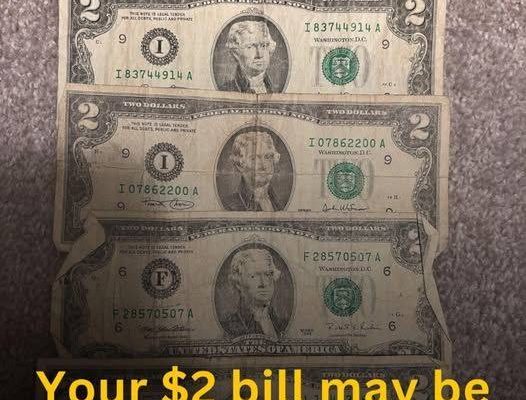At one time, individuals with superstitions regarded the $2 bill as ‘unlucky’ and believed it carried a curse.
However, the $2 bill does not bring misfortune to its possessor; rather, it has the potential to bring considerable luck and even a few thousand dollars.
Continue reading to discover how to assess the value of your $2 bill! Historically viewed as the less favored counterpart to the $1 bill, the $2 note has frequently been dismissed by numerous Americans.
Some even perceive $2 bills as rare, believing they are no longer printed or have been withdrawn from circulation.
Nevertheless, in 2023, the Federal Reserve reported that there were 1.6 billion new $2 bills in circulation, a minuscule figure compared to 14.5 billion $1 bills and 11.2 billion $20 bills.
Historically undervalued, the two-dollar banknote has experienced a resurgence over the last two decades, with its circulation rising from a mere 0.07 billion in 2004, a tiny portion of the $24.2 billion in total currency that year.
The Bureau of Engraving and Printing (BEP) notes that for much of its existence, the $2 note has been unpopular, often regarded as unlucky or cumbersome for transactions.
Many notes were returned to the Treasury with torn corners, rendering them mutilated and unsuitable for reissue, as superstitious individuals believed that damaging the corners could lift the supposed curse.
Additionally, a 1925 article in the New York Times stated, ‘A person who carries a two-dollar bill while gambling is considered to be burdened with bad luck, leading to its avoidance as a token of misfortune.’
The banknote has even inspired a documentary titled The Two Dollar Bill, released in 2015, which delves into its history and the various superstitions associated with it.
Although the $2 bill is not widely recognized, it remains undervalued and is intrinsically worth two dollars. Certain $2 notes, however, can be worth thousands.
The first official $2 banknote was issued in 1862, featuring Alexander Hamilton, the U.S. Secretary of the Treasury and a Founding Father, on the front.
In 1869, the bill was redesigned to display a portrait of Thomas Jefferson, the third president of the United States, a design that has persisted to the present day.
The reverse side originally depicted Monticello, Jefferson’s estate in Virginia, but was later altered to showcase a vignette of the signing of the Declaration of Independence, a significant document written by Jefferson.
Although the $2 bill is closely associated with Jefferson’s image, it has undergone various modifications on the reverse side, as well as some alterations on the front, including changes in the photo’s size and placement, along with the introduction of additional colors.
Furthermore, certain bills may possess a value significantly exceeding their face value. To determine the worth of your $2 bill, examine the year of issue and the color of the seal.
Pristine, uncirculated bills featuring red, brown, or blue seals from 1862 to 1896 can command prices around $5,000 at U.S. Currency Auctions. Conversely, circulated bills from the same period, even if slightly worn, may still be valued at up to $1,100.
Additionally, paper notes with red or blue seals issued between 1917 and 1928 can range in value from $50 to $1,000, contingent upon their condition. T
he auction platform indicates that collectors base their offers on various factors, including the printing method and the location of issuance.
Moreover, some notes may feature ‘fancy serial numbers,’ and if you happen to possess one of these exceptionally rare notes, your two-dollar bill could potentially be valued at as much as $6,000. Do you own a rare $2 bill? We invite you to share your thoughts on this narrative and encourage you to disseminate it among your acquaintances!



